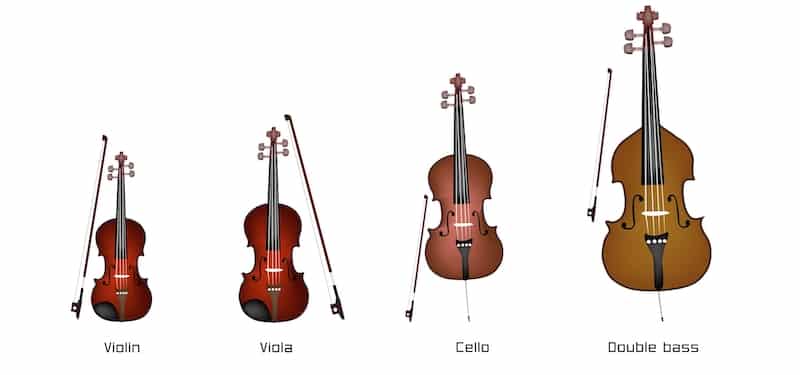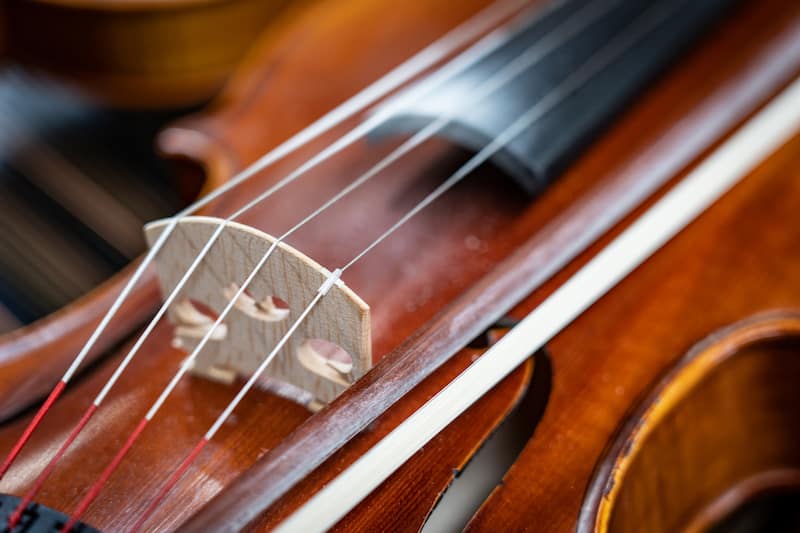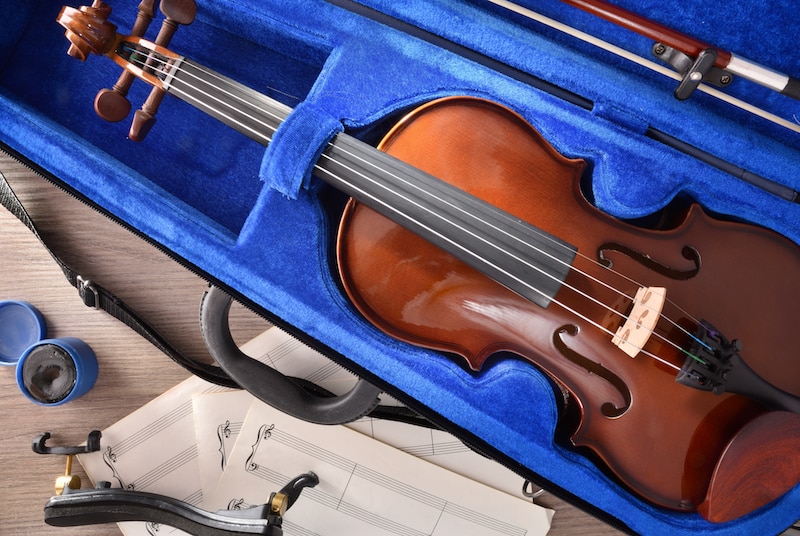The violin and the viola are both stringed instruments that are played using bowing techniques and to many people, often look and sound exactly the same. But despite looking so similar there are several key differences between the two stringed instruments, making both instruments complementary to one another.
In this post, we’re going to answer the question of what’s the difference between a viola and a violin and explore their differences and what they have in common.
History of the Two Instruments

The history of the violin and the viola are very similar as they both share the same origin story.
They’re both members of the violin family, a family of stringed instruments which also include the cello and double bass.
The violin and the viola were developed in Italy during the early 16th century.
Over time, with changes in orchestral sounds, technology, and stringed techniques, the violin family developed into the four instruments that it consists of today.
The violin family was developed to imitate the four voices in a choir, with the violin as the soprano voice, the viola as the alto voice, the cello as the tenor voice, and the double bass as the bass voice.
These are the reasons that the violin, viola, cello, and double bass complement each other so well.
Each instrument in the violin family has also gotten its name from the root word “viola”, with the instrument that is currently known as the viola formerly named the violone.
Size
While they may appear the same to the untrained eye, the violin and viola are actually different sizes with the viola being the larger of the two instruments.
There are six sizes that are available for the viola, with the sizes ranging from 12 inches to 16 inches; the sizes are measurements of the length of the viola’s body.
Violins are available in nine different sizes, and the largest violin size has a body that is 14 inches long.
Strings

When it comes to the strings on the two instruments, violins and violas both have G-strings, D-Strings, and A-strings.
The strings of both instruments have physical differences in length, but their notes are all the same.
Depending on the sizes of the violin and the viola, the G, D, and A strings can even be switched between the instruments.
A violinist and a violist can play the same passages as one another, as a duet, on their three common strings with minor differences in their tones.
But, while they have three strings that are the same, violins have a higher string that is known as an E-string, while violas have a lower string that is known as a C-string.
Viola strings are also typically thicker than violin strings.
Ranges
Due to their different strings, violins and violas are capable of playing in different ranges.
Violins, which have their higher E-string, can play much higher pitches than violas.
Violas, which have the lower C-string, can play lower pitches than the violin.
However, there is a crossover in the ranges that both violins and violas play in due to the fact that three of the four strings of each instrument are the same.
This means they have more notes in common with one another than they have with extraneous notes.
Clefs

Despite having a similar range, violinists and violists play in different clefs.
Violinists play in treble clef, which allows them to read higher-pitched notes on their top E string without having to read lots of ledger lines.
Violists, on the other hand, play in the alto clef (also known as the viola clef) which allows them to read lower-range notes within staff lines as well.
Viola music, however, is also written in treble clef when higher notes need to be played.
Therefore, most violists are required to read both alto clef and treble clef.
Tone
As a result of their different sizes, the tones that violins and violas produce are different than one another.
Violas, due to their larger size and thicker strings, are capable of producing larger, warmer, and deeper tones than violins.
Violins commonly produce brighter and crisper tones than violas.
Playing Style and Techniques
Violins and violas are both played by placing the instruments underneath the musician’s chin and using a bow to play their notes.
Vibrato, a technique that is used to rapidly alter the sound of a note, is used in the same way on a violin as it is on a viola.
To use vibrato, a violinist and a violist both vibrate their wrists in back and forth motions.
For a cello and a bass, however, vibrato is done by a player vibrating their wrist in an up and down motion.
There are a multitude of other playing techniques, such as pizzicato, ricochet, or staccato, that are shared by both violinists and violists.
Accessories

Violins and violas are available with a range of accessories and most of them can be used on both the violins and violas.
The accessories mainly differ in size and proportions, but violin and viola accessories can often be interchanged with one another.
The most common accessory that violins and violas share is a shoulder rest.
A shoulder rest provides support for a violin and a viola, allowing the instrument to fit more comfortably underneath a player’s chin.
However, violin shoulder rests and viola shoulder rests cannot typically be switched due to the different widths of the instruments and the constructions of the shoulder rests.
Though violas are played with bows that have larger frog sizes than violin bows, which adds weight to the bow, violinists and violists can use one another’s bows to play their instruments.
Depending on the player’s technique, there may be a slight difference in their immediate sound quality, but the difference may be unnoticeable to the untrained ear.
A viola bow weighs slightly more than a violin bow so that the violist can draw out the tones of the viola’s thicker C-string.
In contrast, a violin, which is smaller in size than a viola, requires less weight on its strings to produce a great sound.
The rosin, a sticky substance that allows a bow to produce sound from a stringed instrument’s strings, that violinists and violists use for their bows is usually the same.
Violists and violinists may prefer to use different types of rosin, depending on the sounds that they would like to achieve, but each type of rosin can be used on either instrument.
The rosin that is sold for violins and violas is also often used by cellists as well but not double bassists as these require a softer rosin.
Summing up
As you can see, violins and violas are both great instruments that have a lot more in common than they have differences.
Both instruments are exciting to play and many violinists and violists exchange instruments with each other on occasion.
There are also many professional violists who used to be violinists, professional violinists who used to be violists, and professional musicians who choose to play both instruments.
Learning either instrument involves learning how to read the different clefs more than it involves learning how to play the actual instruments as the technique is the same.

